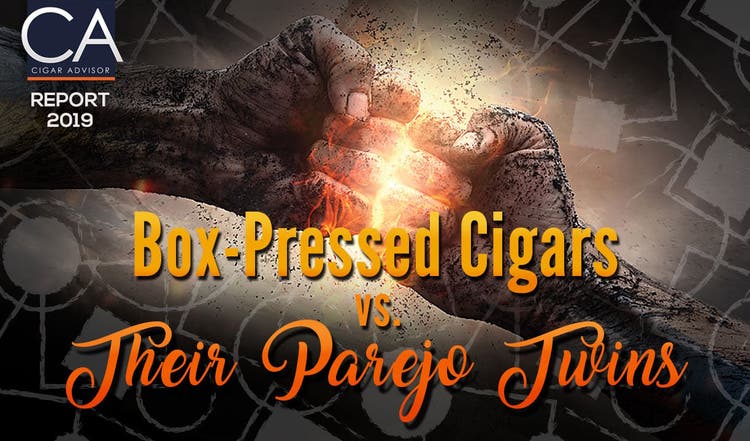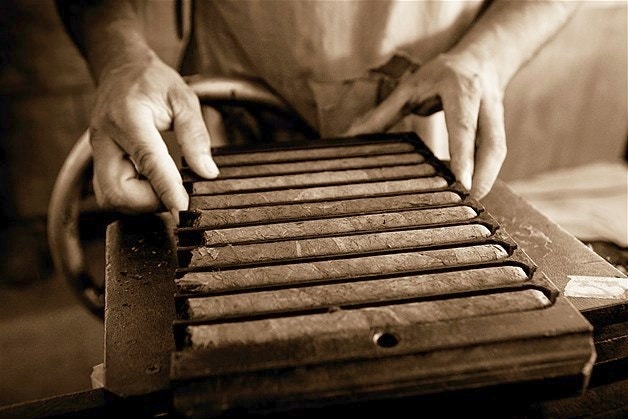
2019 CA Report: Box-Pressed vs. Parejo Cigars
Box-Pressed Cigars vs. Their Parejo Twins
Is There a Difference in Taste between Box-Pressed Cigars and Parejos of the Same Blend and Size?
Let’s say that some mad scientist cloned you as you are now. Everything about your duplicate was exactly the same internally, but your appearance was a little—off. Maybe your hands were bigger, your shoulders narrower, and your gut was fatter. Even accepting those physical differences, do you think your new “twin” would have your same personality? Like the same foods? Enjoy smoking the same cigars?
In the world of sci-fi, anything goes. But in the real world, at least in the premium cigar-blending universe, this kind of thing happens fairly often. The blends and measurements are identical yet, the key difference is, one version of the cigar is round, while the other is square. Besides that, it’s the same cigar. . . or, is it? First, let’s take a look at the main differences between the two shapes.
Referred to as a parejo (pah-reh-hō) in the cigar industry, the majority of premium cigars are rolled in round shapes. In Latin American parlance, the word means “even,” which makes sense when you think about it. So, who would’ve thought to roll a cigar and then make it square? (Talk about the proverbial square peg in the round hole.) Known as box-pressed cigars, or “square-pressed,” not to mention the sharper-edged, trunk-pressed cigars, the origin of box-pressed cigars comes with several myths, which make for interesting debate.

Although parejos are more popular, there are many cigar smokers who won’t smoke anything but a box-pressed vitola. Box-pressed cigars use a little less tobacco to make-up for the final squeezing that awaits them. That alone can factor into a difference in flavor and complexity. And because they are naturally more compressed, box-pressed cigars have less air inside, so they tend to burn longer than parejos.
On the other hand, many cigar smokers find parejos more comfortable to hold in their hands and mouths. And since most new cigar smokers tend to start with parejos, they’re used to smoking round-shaped cigars. Moreover, in terms of the variety of blends available, there are a lot more premium parejos to choose from than box-pressed cigars for sale.
Generally speaking, there are going to be shape and blend differences between the two formats. So, I thought it would be fun to look at a number of box-pressed and parejo cigars that have identical blends, lengths, and ring gauges to see if there are any noteworthy flavor differences between them. The only spoiler I’ll give you is that, on average, all of the box-pressed versions smoked about a half-hour longer.
Asylum 13 Medulla & Oblongata Toro Corojo
Size: 6″ x 52
Strength: Full
Wrapper: Honduran Corojo
Binder & Filler: Honduran Corojo & Criollo
Box Press:
Parejo:
The nice thing about the Asylum 13 Medulla Oblongata selection is that they come in boxes with equal amounts of both formats. Released in 2018, I guess Asylum founder, Tom Lazuka, got ahead of me on this one. It’s also one of the most ambitious premium projects on the market. The Medulla are the parejos, and the Oblongata are the box-pressed sizes. All of the tobaccos in these solidly-built puros are grown on Christian “CLE Cigars” Eiroa’s Corojo farm, and the Corojo wrappers, grown from authentic Cuban seed, are exquisite, to say the least. Both cigars offer pitch-perfect balance along with a copious amount of creamy smoke that brims with well-defined flavors of cedar, sweet spice, coffee and a splash of vanilla caramel.
The Verdict: In this case, it’s pretty hard to tell the two formats apart in terms of their overall flavor profile, but the box-pressed Oblongata was smoother, creamier, and offered a little more sweetness.
Camacho Ecuador BXP Toro & Ecuador Toro
Size: 6″ x 50
Strength: Full
Wrapper: Ecuador Habano
Binder: Brazilian Mata Fina
Filler: 2 high-priming Honduran fillers and Dominican Pelo de Oro ligero
Box Press:
Parejo:
This is one of the dark horses from Camacho Cigars that you don’t hear too much about. Yet, if you ask Camacho smokers about the Camacho Ecuador selection, they typically agree that it’s one of the company’s best blends. The Ecuador Habano wrappers are gorgeous and have a dark, leathery appearance – even more so on the box-pressed version – while the interior has a naturally sweet Brazilian Mata Fina that binds an all high-priming Honduran-Dominican core. In a nutshell, Camacho Ecuador is a bona fide flavor bomb. An initial pepper blast rounds-out to a tangy, citrusy mix of dense, creamy-smooth smoke that shifts from spicy to sweet in well-balanced waves throughout for an impressively complex smoke.
The Verdict: The parejo runs more to the tangy-citrusy side with a bit more earth and pepper, while the BXP was markedly sweeter. This may have been due to the BXP having a little less filler, allowing more sweetness from the binder. It’s also a little smoother on the palate and has a more abundant volume of smoke.
Davidoff Nicaragua Box-Pressed Toro & Toro
Size: 6″ x 52
Strength: Full
Wrapper: Nicaraguan Habano
Binder: Nicaraguan Jalapa Habano
Filler: Nicaraguan Estelí Viso, Condega Ligero, Ometepe Viso
Box Press:
Parejo:
The Davidoff Nicaragua selection was Davidoff’s first foray into a non-Dominican blend. It took a 10 year effort, but what emerged was a tour de force puro. The idea was to create a blend that would stimulate the bitter and sweet taste buds. True to form, the parejo is ultra-smooth, equally creamy, and starts out very spicy; then gradually transitions to notes of sweetness, spice, espresso, cedar, and bitter-sweet chocolate for a full-bodied, complex adventure from end-to-end. To its credit, in 2013 the Toro parejo at landed the #3 slot in Aficionado’s “Top 25 Cigars of the Year” with a “Classic” 95 rating.
The Davidoff Nicaragua box-pressed version carries a virtually identical flavor profile in just about every respect. There is one exception that I overlooked, and I apologize for my research lacking on this one. Although the blends are identical at the core, and rolled in Nicaraguan Habano wrappers, the parejo uses a Habano Rosado, while the box-pressed version has a Habano Oscuro wrapper.
The Verdict: I’ve smoked both cigars on numerous occasions, and found scarcely much difference between the base flavors. However, due to having the Habano Oscuro wrapper, the box-pressed Toro offers a little more sweetness, and the smoke is much creamier. The bottom line is: Both formats successfully provide the bitter and sweet stimulation Davidoff envisioned.
Laranja Reserva Caixa (Box-Pressed) & Laranja Reserva Volta (Parejo)
Size: 6½” x 48
Strength: Medium-plus
Wrapper: Brazilian Laranja
Binder & Filler: Nicaragua
Box Press:
Parejo:
The Laranja Reserva selection boasts a rare Brazilian wrapper which La Zona Cigars founder, Erik Espinosa, named Laranja – Portuguese for “orange” – for its unique orange patina and redolent aroma. The wrapper also lends a tangy citrus note that’s similar to oranges. The Laranja Reserva Toro earned a 94 rating score in Aficionado, and at 6½-inches by 48 ring, the box-pressed Caixa and parejo-shaped Volta aren’t too far off from the Toro.
The box-pressed Caixa (Portuguese for “box”) has a peppery start, but quickly rounds to a creamy-smooth mélange of sweet spice, nutmeg, graham cracker, and that intriguing note of orange zest. Transitioning from medium to medium-plus, the smoke offers a long and creamy finish with some pleasant lingering spice.
As to the Laranja Reserva Volta, which is made expressly for Famous Smoke Shop, this parejo version comes in a humijar of 10 cigars instead of a box of 20. For cigar smokers who don’t smoke box-pressed cigars the Volta is not only on-par with the Caixa, it’s easier on the wallet, plus, you get the humijar, but they do share a similar single cigar price.
The Verdict: Despite the difference in their shapes, these are two of the closest competitors in terms of their flavor and character; therefore, it’s just a matter of preference. Both cigars are highly consistent from smoke-to-smoke, and well worth trying.
Romeo y Julieta House of Capulet Famous 80th Anniversary Toro & Capulet Toro
Size: 6″ x 52
Strength: Medium
Wrapper: Ecuador Connecticut
Binder: Nicaragua
Filler: Nicaragua, Honduras
Box Press:
Parejo:
The House of Capulet cigars are one among a trio of Romeo y Julieta “House of” blends made exclusively for Famous Smoke Shop. This medium-bodied blend features a well-balanced core of Nicaraguan and Honduran long-fillers framed by a Nicaraguan binder and capped with a savory Ecuadorian Connecticut wrapper. The Romeo y Julieta House of Capulet Toro parejo reveals a smooth, creamy smoke with base notes of cedar, nuts, leather, and a pleasant toastiness that segues to a sweet spiciness, not unlike that of cinnamon, in the latter stages.
This year, the Romeo y Julieta House of Capulet Famous 80th Anniversary cigar made its debut, and if you watched Cigar Advisor’s video review of the Romeo y Julieta House of Capulet Famous 80th Anniversary cigar, it’s probably the one cigar in this list that does differ the most from its fraternal twin. This box-pressed vitola offered notes of salted nuts, graham cracker, toffee, oak, sweet spice, and some light earthiness. It also has more transitions along the way, and doesn’t retain as much sweetness as the parejo.
The Verdict: As noted above, these two cigars, despite having the same blend and measurements, were markedly different. Even though the box-pressing on the 80th Anniversary is very sharp, my fellow reviewers and I concluded that the pressing must have had something to do with it. As CigarAdvisor.com Managing Editor, John Pullo, noted in his text review, “the flavors are much more forward” in the 80th. Moreover, this is the cigar that actually inspired me to write this article.
Conclusions
In most of the cases above, the flavor profiles were pretty close. It could be because all 10 selections are top-drawer blends, and when you have great tobacco it’s hard to miss. Therefore, I suggest that at some point you give these cigars a try in both formats. If you’re not accustomed to the look and feel of box-pressed cigars, maybe this article will spark your curiosity. After all, Padron cigars are made in all box-pressed sizes, and they’re among the most desirable cigars on the planet. Like most things when it comes to premium cigars, preference rules and individual tastes vary. However, if you do decide to take up the challenge, you may find some pleasing flavors I overlooked and find yourself preferring one shape over the other. As always, enjoy, and please leave a comment if you do.









